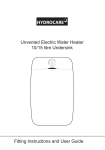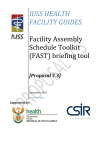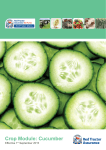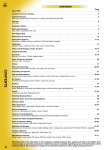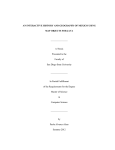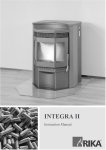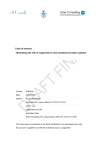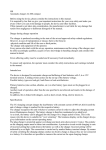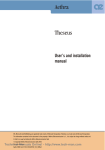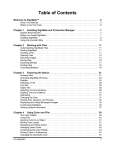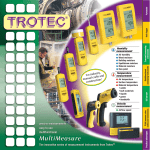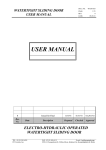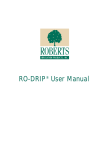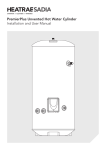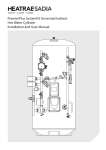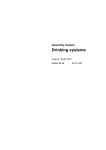Download Chemigation considerations
Transcript
CONTENTS Chemigation 1 Introduction ........................................................................................................................................................................................................................................... 13.1 1.1 Classification ....................................................................................................................................................................................................................... 13.1 1.2 Benefits and disadvantages ................................................................................................................................................................................. 13.2 1.2.1 Benefits ...................................................................................................................................................................................................................... 13.2 1.2.2 Disadvantages .................................................................................................................................................................................................... 13.2 1.3 Chemigation considerations ............................................................................................................................................................................... 13.3 1.4 Irrigation system considerations................................................................................................................................................................... 13.4 2 Fertigation ............................................................................................................................................................................................................................................... 13.5 2.1 Types of fertilizer products ................................................................................................................................................................................. 13.5 2.2 Choice of fertilizer products .............................................................................................................................................................................. 13.7 2.2.1 Water soluble fertilizer ......................................................................................................................................................................... 13.10 2.2.2 Liquid fertilizer .............................................................................................................................................................................................................. 3 Pesticides ............................................................................................................................................................................................................................................... 13.11 4 Equipment ............................................................................................................................................................................................................................................ 13.12 4.1 Choice of different types of injectors ................................................................................................................................................... 13.12 4.2 Injectors .................................................................................................................................................................................................................................. 13.12 4.2.1 Passive injectors ........................................................................................................................................................................................... 13.13 4.2.2 Active injectors .............................................................................................................................................................................................. 13.13 4.2.2.1 Electrically driven pumps.................................................................................................................................................. 13.16 4.2.2.2 Hydraulically driven pumps ........................................................................................................................................... 13.16 4.3 Other equipment ........................................................................................................................................................................................................... 13.18 4.3.1 Electrical interlock ..................................................................................................................................................................................... 13.22 4.3.2 Flow sensor ........................................................................................................................................................................................................ 13.22 4.3.3 Chemical injection line check valve...................................................................................................................................... 13.22 4.3.4 Manual valve .................................................................................................................................................................................................... 13.22 4.3.5 Strainer on suction pipe of chemical injector ............................................................................................................. 13.22 4.3.6 Air valve ................................................................................................................................................................................................................ 13.23 4.3.7 Chemical supply tanks .......................................................................................................................................................................... 13.23 4.3.8 Agitators ................................................................................................................................................................................................................ 13.24 4.3.9 Static in-line mixer .................................................................................................................................................................................... 13.24 4.3.10 Fresh water supply valve ................................................................................................................................................................ 13.24 4.3.11 Filters ..................................................................................................................................................................................................................... 13.24 4.3.12 Equipment for mixing of fertilizers .................................................................................................................................... 13.24 4.4 Electronic control ........................................................................................................................................................................................................ 13.25 4.4.1 Electrical conductivity control ..................................................................................................................................................... 13.25 4.4.2 pH-control............................................................................................................................................................................................................ 13.26 4.5 Safety measures ............................................................................................................................................................................................................. 13.26 5 Injection of fertilizer solutions ..................................................................................................................................................................................... 13.27 5.1 Examples for the calculation of injection rates ......................................................................................................................... 13.27 5.1.1 Static systems .................................................................................................................................................................................................. 13.28 5.1.2 Moving systems ............................................................................................................................................................................................ 13.31 6 Legislation in South Africa .............................................................................................................................................................................................. 13.34 6.1 The Environmental Conservation Act ................................................................................................................................................. 13.34 6.2 The Agricultural Resources Conservation Act.......................................................................................................................... 13.34 6.2.1 Regulation 6: Prevention of salinisation and saturation of irrigated land .................................. 13.35 6.3 The Health Act ............................................................................................................................................................................................................... 13.35 6.4 The National Water Act ....................................................................................................................................................................................... 13.35 8 References............................................................................................................................................................................................................................................ 13.37 All rights reserved Copyright 2003 ARC-Institute for Agricultural Engineering (ARC-ILI) ISBN 1-919849-24-6 Chemigation 13.1 1 Introduction Chemigation is the application of agricultural chemicals (fertilizer, fungicides, herbicides, nematodes, soil improvement remedies, growth regulators, sewage and manure water), in an effective and economic way, by means of an irrigation system. Chemigation can be applied by means of any type of irrigation system, although some flood irrigation systems may not be suitable for the application of certain types of chemicals, because of poor application uniformity. The careless use of chemicals and over-irrigation must also be prevented, because it can lead to pollution of soil and water sources. The prescribed safety measures as described in Section 4.5 must be followed meticulously. The purpose of this manual is to serve as guidelines for producers and irrigation designers regarding chemigation. The various suppliers of different chemicals must be consulted to ensure that the product is applied safely and correctly. 1.1 Classification The most important methods of application of agricultural chemicals can be described as follows: • Fertigation Fertigation comprises the application of dissolved nutrients for crops by means of an irrigation system. The total or part requirement of specific elements can be divided and applied through the irrigation system. Uncompounded products or combinations of products and liquid or water soluble forms can be used. Fertigation is essential in irrigation systems, because the root systems of the crops are limited to the wetted soil volume. • Herbigation The effective application of herbicides by means of an irrigation system depends a great deal on the type of irrigation system in use. Compared to drip irrigation, herbicide application is more successful when applied by means of micro-sprayer, sprinklers and moving systems. The effectiveness of herbicide application depends on the movement of herbicides through soil, which is a function of solubleness, volatility and the absorption of the herbicide. • Nematodigation Good nematode control is obtained with nematode substances which are specially formulated for application by means of an irrigation system. The products are very poisonous and systemic and must be used responsibly and with great care. Nematode spray can be applied by means of any irrigation system except with flood irrigation. The type of soil determines the amount of irrigation water to be applied for application of the nematode substances to the required depth. • Insectigation The use of the irrigation system for the control of insects, will depend upon the chemical compound of the insecticide, special requirements of the crop during various stages of growth and the effectiveness of the insecticide when applied by means of the irrigation system. Producers must always follow the directives prescribed on the label of the product when insect spraying is applied. Insecticides are mostly applied by means of pivot and sprinkler irrigation systems. 13.2 Irrigation User’s Manual • Fungigation The application of fungicides by means of an irrigation system for disease control is called fungigation. Effective application can be obtained by means of pivot, permanent and movable sprinkler systems. The fungicides can be applied on the leaves or on the soil. The accuracy of fungigation is not as critical as with weed spraying, as the crop is not damaged by high applications. Ensure that the leaf cover is always sufficient. The cover depends on the fungicide compound, the amount of cover and the uniformity of the water application by the irrigation system. For effective leaf cover with the fungicides, products that do not wash off easily and a smaller water application must be used. For soil application, the fungicide that washes off easily must be used for sufficient soil coverage. 1.2 Benefits and disadvantages Just as there are benefits and disadvantages of applying agricultural chemicals by means of conventional methods (ground and air application), chemigation also has benefits and disadvantages. 1.2.1 Benefits • Well-designed and well-managed irrigation systems can apply agricultural chemicals more uniformly than an aeroplane or as ground equipment. • Chemigation can be done even if the lands are too wet for tractors or too misty for application by aeroplane. Application can also be done when optimal weather conditions prevail. • The chemicals applied, can be washed into the soil to the required depth and soil moisture can simultaneously be provided for the effective functioning of certain chemicals. • Chemigation can be applied under different soil tilling practices. • Mechanical damage to crops is limited to the minimum with chemigation. • Compaction of the soil by tractors is prevented by the use of chemigation. • Chemigation reduces the operator’s exposure to the chemicals. • Chemigation reduces the danger of environmental pollution which normally accompanies water losses resulting from unfavourable weather conditions. • Time and labour cost is reduced by using chemigation. • Chemigation can reduce energy costs by as much as 90%. • Chemigation can prevent leaching of especially fertilizer products beneath the root zone with accompanying pollution of subsurface water sources by applying the correct management. 1.2.2 Disadvantages • • • • Chemigation requires a high standard of management. Staff must therefore be well-trained. Some chemicals may be corrosive for certain irrigation equipment. Some additional equipment and capital outlay may be necessary for chemigation. Water pollution of the water source is a possibility if the correct backflow prevention valves are not installed. Safety measures must be strictly adhered to, especially where drinking water is concerned. • Not all chemicals are suitable for chemigation. • Chemigation requires more time than aerial spraying, therefore certain climatic factors (e.g. strong winds) can delay application. Chemigation 13.3 1.3 Chemigation considerations • Application The quantity of chemicals as well as the uniformity of application must be accurate in accordance with the supplier’s prescriptions. Run-off is not only influenced by the application rate of the irrigation system and the infiltration rate of the soil, but also by the slope of the field, soil coverage, the crop growth and the water content of the soil. Measures to prevent excess run-off, must be instituted timely to prevent pollution. Excess run-off can also have an uneven distribution of the chemicals on the soil. • Solubility Some chemicals used in agriculture are insoluble in water or not very soluble. If the chemicals are blended together, insoluble matter may be formed, which blocks filters and nozzles. A glass jar may be used to determine the solubility of the chemicals. Add the chemicals to the water in the jar according to the mixing prescription. Mix well and let it stand for a few hours for observation. If precipitation forms, problems can be expected. Highly soluble mixtures usually infiltrate the soil deeper than mixtures which are less soluble. It is also more easily absorbed by the plants if applied near the roots. Not all less-soluble mixtures infiltrate the soil with the water and often collect on the upper layer of the soil and can be poisonous to the plants as a result of the high concentration. • Volatility Volatility is the characteristic of a liquid to change into a gas. It is dependant on the vapour pressure. The lower the vapour pressure, the easier the chemical will evaporate, or vice versa. Some chemicals are more volatile than others and will therefore volatilise or evaporate more easily. The finer the drops, the larger the exposed surface will be and the easier the chemical will evaporate and its effectiveness will be influenced. • Adsorption Adsorption is important for the chemical to be effective, whether by plants or by the soil. Good absorption by plants is obtained by means of ideal weather conditions, e.g. no wind or rain. The measure of movement of a chemical in the soil is a function of solubility, adsorption and volatility. It is important to know how deep a chemical substance will move in the soil. The chemical usually moves only a part of the depth of the water in which it is dissolved as a result of adsorption. Most weed seeds germinate in the upper layer of soil and it is therefore important to apply the chemical to this area. If too much water is used, the chemical will move past the area where it should be placed. Too little water, however, will cause the chemical to be placed too shallow, where it will be exposed to evaporation and breakup by the ultraviolet rays of the sun. The soil also dries out too soon and the chemical is not as active as it should be. • Climatic conditions Strong winds change the distribution pattern of the spray nozzle, which results in the chemical not being distributed evenly. With moving irrigation systems, the influence of wind is not as high as with static irrigation systems. When the wind speed exceeds 7 km/h, chemigation must be stopped on all systems except with drip systems. It is recommended that chemigation is done during windlessness. Wind, high temperatures and relatively low relative humidity increase evaporation of the chemicals. 13.4 Irrigation User’s Manual • Soil factors A herbicide’s action is influenced by the texture, ground water and the organic content of the soil. The clay particles in the soil constrain the herbicide and the higher the clay content, the more herbicide is constrained. In sandy soils the herbicide is leached easier than in clay soils. The soil water content is also important, because if the soil is too wet, the chemical does not compound with the soil particles, but it volatilises or leaches. 1.4 Irrigation system considerations The characteristics of the irrigation system determine the type of injectors, choice of chemicals which can be applied, injection rate and duration of injection. Irrigation systems used for chemigation must be in good working order and management must be done in an environmentally friendly manner. The choice of the most suitable injectors for a specific producer’s circumstances is also very important. Irrigation systems can be divided into three categories, namely flood, static and moving systems. Static systems include micro-sprinklers, drip, portable as well as permanent sprinkler systems. These systems irrigate a field at a constant application rate. The required quantity of chemicals can then be mixed and dosed over the standing time of the irrigation system. Some chemicals must be washed deep into the soil, while other such as nitrates are very mobile and must be applied with the minimum of water. Moving systems such as pivots, moving guns and linear systems has a varying application rate. The injection rate of the chemicals must be synchronised with the running speed. The application uniformity (CU) and the emitter uniformity (EU) of the designed system must conform to the prescribed SABI design norms to ensure uniform application. See Chapter 3: Planning and evaluation of an irrigation design of this manual. It is important that the irrigation system is evaluated in the field to ensure that the system conforms to the specified evaluation norms before chemigation is applied. The system must also be set at the required operating pressure before chemigation is begun. The following procedure can be used as guidelines in the management of a chemigation system: • Determine the flow rate for the number of blocks, the block surfaces as well as the number of plants per block, before starting chemigation. • Before chemigation is applied, ensure that the lines’ pressure is at the required operating pressure. • To ensure uniform application, sprinkler systems must spray for at least 1 hour. Chemicals that require a short injection period, must be applied for at least 15 minutes. • The irrigation system must be flushed after chemigation. A flushing time of 30 minutes should be sufficient for most systems, depending on the system design, e.g., systems with large mainlines may need longer flushing times. A dye may be added to the irrigation water to determine the time it takes for the water to move from the injection point to the emitter. • The chemicals must preferably be applied per irrigation block, to ensure that the chemicals are applied uniformly and that the irrigation lines are flushed thoroughly. • If chemicals that may damage the leaves are applied, the irrigation system must preferably irrigate 1 hour after injection is stopped. Chemigation 13.5 2 Fertigation Fertigation contains the application of dissolved nutrients by means of an irrigation system. The total or part requirement for specific elements can be divided and applied by the irrigation system. Uncompounded products or combinations of products in liquid or water soluble form can be used. The main purpose of fertigation is the maximum production of good quality fruit by means of the optimal utilisation of water and fertilizer, as well as the manipulation of plant physiology processes to ensure optimal vegetative growth. These production objectives (yield and quality) are determined by the market for which production is done and are influenced by the fertigation program followed. The soil or medium in which cultivation is done, is used as storage or buffer (the soil’s resistance to drastic chemical changes) from which the plant can absorb fertilizers freely. A fertigation program is compiled, considering the fertilizer contribution of the irrigation water and the soil’s nutritional balance. The compound of irrigation water and chemicals, as well as the chemical and physical interactions between soil or medium, can however seriously influence the ability of the soil or medium to act as buffer. Fertigation is more important in cases of sandy, gravelly, or stony soil with a low nutritional retention ability, as well as chemically poor-balanced soils and irrigation water combinations. The use of localised wetting irrigation systems, e.g. drip irrigation systems, has the result that less dependance is needed from the soil’s provision and buffer ability. 2.1 Types of fertilizer products Fertilizer products are available in a water soluble granular, powder or liquid form. The choice between the different types will depend on the storage space available, the available injectors, product stability, ease of handling, injection method, cost and the acidification possibility of the fertilizer. Based on the primary fertilizer content (N, P, K), fertilizer is given a name consisting of three parts. This relation demonstrates the quantity of nitrogen (N), phosphate (P), and calcium (K) content of the fertilizer in terms of its weight percentage. The compilation of a fertigation program will mostly be the result of the production objectives of the producers, the physiological stage of the crop, the chemical compound of the irrigation water and the soil, as well as the irrigation system in use. Two concepts are at hand when referring to fertigation. The first is when fertilizer products are applied by means of an irrigation system. A time scale of thought is applicable here, e.g. the nutrients can be applied annually, weekly or even daily. This approach does not mean that the nutrients must be present in the irrigation water each time that irrigation is applied. Single elements, such as only nitrogen, or a combination of elements, such as a combination of nitrogen, phosphate or calcium can be applied together. In general, the shorter the time scale, the more balanced, more expensive and more plant absorbent the fertigation program should be. With localised wetting irrigation systems e.g. drip systems, the crop usually has an intensive localised root system. The time scale reduces drastically and nutritional supplement must be given at short intervals, e.g. by maintaining continuous nutritional balances within the root zone. The second approach is that water for irrigation must be enriched with nutrients and every time irrigation is applied, completely balanced nutrient elements must be present. This approach is referred in general as the hydroponic approach and where it is applied under field conditions, it is known as the open hydroponic approach. Where this nutritional approach is followed, the nutrients and the pH of the irrigation water is controlled by means of an irrigation computer and adapted to the physiological stage of the plant. Fertilizer concentration can be indicated as kg or litre per ha, kg or litre per cubic metre irrigation water and electrical conductivity (EC) at or without a certain pH. Electrical conductivity (EC) is an indication of the irrigation water’s natural salt content and the composition of the fertilizer mixture. If a certain quantity of a certain fertilizer product is applied in water, it will indicate a certain electrical conductivity value. This value is proportional to the quantity of the product in the water and EC can therefore be used to control the quantity of nutrients that is applied. The ideal water-pH with which irrigation is applied, is between 5,6 and 6,2, because in this pH-series, 13.6 Irrigation User’s Manual elements are the most absorbent by plants. Plants adapt to a certain pH and EC and a great deviation therefrom causes plants to use the energy which it should have used for production, to adapt to new conditions. This results in accompanying reduction or discontinuance of growth and production. It is exactly the approach to expose plants, to constant EC and pH levels as far as possible with the open system. Hydroponics can lead to maximum production that is not possible by any other means. • Nitrogen Nitrogen is the element mostly required and therefore applied the most. A suitable nitrogen (N) concentration is dependent on the production objectives and crop requirements. Movement of nitrogen through the soil and absorbency of the nitrogen source depend on the type of nitrogen source and percentage available nitrogen in the source. Different soils will show different reactions with nitrogen through the water and the correct choice of the N-source can, in some cases, result in a significant difference in yield. At low application levels, ammonium (NH +4 ), which is positive and therefore adsorbs on the negative clay particles, will have the result that the movement thereof is limited in the soil. As soon as ammonium application is increased and the exchanging capacity of the soil is overcome, the movement of ammonium through the soil will also increase at a rate which is dependent on the soil type. At a soil temperature of 25°C to 30°C, the ammonium will be biologically transformed to a nitrate (NO 3− ). This process is called nitrification. If the soil remains too wet as a result of irrigation or rain, the transformation will occur very slowly as a result of a lack of oxygen. Where the soil and irrigations water has a pH of 7 or higher, ammonium will transform into NH3 (ammonium gas) and an N-loss can occur by means of volatility. The solubility of urea is good, is not easily absorbed by the soil and therefore moves into the soil easily - deeper than e.g., ammonium. After the hydrolysis from urea to ammonium, the reactions will be the same as discussed under ammonium. Nitrate (NO 3− ) is negatively loaded exactly as clay particles and therefore the antagonism has the result that the NO 3− ions are not strongly bound to the soil particles. The NO 3− ions usually move to the edge of the wetted area. If over-wetting occurs, the nitrate can be leached out of reach of the plant roots. Any form of applied nitrogen, will eventually be transformed to a nitrate form in the soil and the nitrogen application should therefore take place either periodically or through the irrigation water, or by means of water enrichment on a permanently balanced manner. Except for leaching, denitrifying can result in great N-losses. During the process, NO 3− changes to volatile Nforms. This usually occurs when there is too much water and consequently too little oxygen in the soil. Effective scheduling is therefore a prerequisite to ensure maximum yields under nutritional fertilisation. If NH +4 -ions are dominant in the soil, H + -ions will be withdrawn from the root zone, which will lead to the acidification of the soil solution. The amount of calcium-carbonate required to neutralise the acidity of a specific fertilizer type, is called the calcium carbonate equivalent. When the NO 3− -ion is mainly absorbed, HO − or HCO 3− -ions will be released with a consequent increase in the pH of the soil solution. High soil-pH will reduce the availability of zinc, iron and phosphates for the plant. Chemigation • 13.7 Phosphate The nutritional phosphate-requirements of a crop are the highest during the germination phase or directly after planting. If the water-pH (> 7,5) and especially water with bicarbonate (HCO 3− ) as well as the Ca and Mg content high, sediments of Ca2+ and Mg 2+ phosphates occur very fast. With certain reservations, phosphoric acid can be applied, but the pH must be monitored closely. This must however not be done without the advice of a professional. An incorrect recommendation can result in sedimentation with consequently the total blockage of the entire system. Where pH and the amount of Ca2+, Mg2+ and HCO 3− -ions are low, very few problems will be experienced with Papplications. A low pH (< 5,5) for long periods, can, in the long run, increase the possibility of corrosion of metal equipment and damage the plant roots. • Potassium Potassium seldom causes problems such as blockages and precipitates within irrigation lines. The most general sources of potassium, namely potassium sulphate, (K2SO4), potassium chloride (KCl) and potassium nitrate (KNO3) are reasonably soluble in water and will not cause serious problems. Potassium sulphate and potassium nitrate is preferred over potassium chloride, especially with crops which are salt-sensitive. As soon as the potassium is applied, the K-cation, K+, will adsorb on the clay particles. When the exchange complex of the clay is saturated, the K+ can descend reasonably easy and move sideways in the soil. • Micro elements Micro elements or trace elements are plant nutrients taken up by plants in very small quantities, but fulfill an essential role in the physiology of the plant. In the absence of one or more of these elements, normal growth and reproduction are not possible. When a shortage of micro-elements is experienced, plants show obvious shortage symptoms. The most important micro-elements which are essential for the normal development of the plants are, iron, manganese, boron, copper, zinc and molybdenum. 2.2 Choice of fertilizer products Some irrigation water and fertilizer product-combinations can cause detrimental reactions such as corrosion and precipitating (resulting in blockages). It is therefore recommended that a jar test is first done by adding the fertilizer at the correct concentration to the irrigation water. Monitor the mixture for sediments or milkiness over a period of one or two hours. Milkiness will be an indication that blockage problems are possible. Secondary filters at each block can protect the emitters against potential damage. With the choice of fertilizer products, the following must be kept in mind: • When a dry water soluble fertilizer is used, first fill the tanks halfway to three quarters with water and then add the fertilizer slowly while stirring the water continuously to prevent the forming of large insoluble lumps. Always add the liquid fertilizer to the water in the tank before the dry water soluble fertilizer is added, to ensure the solution of all the fertilizer products. • Fertilizer products that have an acid base, are inclined to cause corrosion of metal and asbestos cement components of an irrigation system. Ensure that the injection and irrigation equipment is resistance to these products. uPVC, polyethylene, polystyrene, Teflon and Grade 316 stainless steel are the most corrosion-resistant commercial materials. Equipment must also be flushed well after use. Furthermore, the lowest possible concentration fertilizer must be used. • Not all fertilizer products are compatible in concentrate form, e.g. products which contain sulphate, are incompatible with products that contain calcium. The result will be the forming of insoluble gypsum. Phosphates are also incompatible with products containing calcium and magnesium. These products must be injected separately from different tanks into an irrigation 13.8 Irrigation User’s Manual pipeline (See Figure 13.1). This separation will prevent the precipitation of calcium phosphates and calcium sulphate in the mixing tank and irrigation system. Injection from the two tanks must take place at least 0,5 m apart. An extra tank is used when acid for the pH-correction of the irrigation water has to be done. When concentrate products are dissolved in tanks, the acids must be mixed in first, then the neutrals and then the alkaline products. Potassium nitrate Magnesium nitrate Calcium nitrate Urea Ammonium nitrate Tank A Mono-ammonia phosphate Mono-potassium phosphate Potassium sulphate Magnesium sulphate Potassium nitrate Urea Ammonium nitrate Tank B Figure 13.1: Permissible combinations of fertilizer solutions (Schneck, 1998) • The different soil and irrigation water combinations can have an acid or alkaline reaction within the root zone. By using specific fertilizer products, this reaction can be counteracted. • The solubility of dry water-soluble fertilizer products increases as the water temperature rises. Although nitrate containing products are highly soluble, the water temperature can drop with up to 20°C. This reduction has the result that three times more water is required for dissolving the product, than at normal temperatures. This means that the injectors capacity must also increase threefold. • Do not mix chlorine and fertilizer, as it will lead to an explosion. Always clean the mixing tank before chlorine is used. The presence of ammonia and urea in the irrigation water will decrease the effectiveness of the chlorine. Chlorine and acid or an acid-based fertilizer product must also not be mixed, because a toxic chlorine gas will form. Always add acid to water, not water to acid, because a massive exothermic reaction can take place, that will make the liquid splash out. The same applies to chlorine, always add the chlorine to the water. • If irrigation water of a neutral to alkaline nature is used for irrigation, acid correction must first be done before calcium and phosphates are applied, e.g. high pH values (> 7,5) in the irrigation water can result in the precipitation of calcium and magnesium carbonates and phosphates that could lead to emitter blockages. The pH-correction of the irrigation water will improve the absorbency of the nutrients, and will prevent the precipitation of impermeable compounds thereof. The ideal pH of fertigation is between 5,6 and 6,2. Some of the most important products and the plant nutrient elements they contain, is shown in Table 13.1. Chemigation 13.9 Table 13.1: Most important fertilizer products (Buys, 1997) Product Nitrogen X Ammonia X Ammonium sulphate X ASN X LAN X UAN X Urea X MAP X DAP X Ammoniated phosphate (16) Super phosphate Double super phosphate Calmafos Langfos Potassium chloride Potassium sulphate Potash magnesium X Potassium nitrate NPK mixtures X Low grade(< 25) X High grade(> 25) X Liquid ASN = Ammonia Sulphate Nitrate LAN = Limestone ammonium nitrate UAN = Urea-ammonia nitrate MAP = Mono-ammonia phosphate DAP = Di-ammonia phosphate Phosphate Potassium Calcium Sulphur Magnesium Chlorine Zinc Boron X X X X X X X X X X X X X X X X X X (X) X X X X X X X X X (X) X X X X X X Oxygen X X X X X X X X X X X X Carbon X X X X X X X X X X X Hydrogen X X X (X) X X X X X (X) (X) X (X) (X) (X) (X) (X) X X X X X X (X) (X) X 13.10 Irrigation User’s Manual 2.2.1 Water soluble fertilizer To apply a fertilizer in granular or powder form, it must be water soluble. The amount of fertilizer that dissolves in a certain volume of water is called the solubility of the mixture. It is recommended that a professional in the field of fertigation be approached on the solubility and miscibility of a specific fertilizer product. A jar test must also be done. 2.2.2 Liquid fertilizer Fertilizer products in liquid form can be divided into three groups (Buys, 1997): (i) Slurries This group is seldom if ever produced. It can be compared to a porridge or thick lime solution used for painting walls. In such a solution, a reasonable amount of solid particles occur, which can settle within hours. (i) Suspensions This group can be compared to the lime water after the large lumps have settled. Settling can however still occur, but can take weeks or months. There are currently two types of suspensions: • Nitro-phosphate suspensions It is manufactured by the treatment of rock phosphate with nitric acid. The initial product can then be further treated to deliver various end products. The relationship of N:P in the products is a 3:2 or 4:1. Nitro-phosphates have a high density and are considered heavy suspensions. • Ammonia phosphate suspension It is manufactured by the reaction of phosphorous with ammonia under controlled conditions. The duration of the reaction and the eventual pH will determine the end product. It can contain a MAP, DAP or both and the N:P-relation is between 2:3 and 3:4. (iii) Solutions In this group, all the components are dissolved entirely. With the exception of N-solution, this group is characterised by low concentrations, seldom higher than 15%. It is mainly as a result of limitations regarding solubility and the necessity to store such products at room temperature without it crystallising. The disadvantage is that transport costs are noticeably higher than for suspensions. Clear solutions were mainly developed for irrigation farmers to enable them to apply fertilizers through the irrigation system. The accuracy of application and the frequency with which it is done on specialised crops, compensates for the increased cost because of the lower concentration of clear solutions. Most mixtures are obtainable in dry form, as well as urea ammonia nitrate (UAN), is also available in liquid form. Because of practical reasons, the concentrations differ from liquid and related dry products. Chemigation 13.11 3 Pesticides Product labels of pesticides must be read carefully beforehand and the directives supplied must be strictly adhered to. Only active injectors can be used to apply pesticides (See Division 4). Pivots with highspeed motors are preferred, especially if pesticides require light application. Avoid application of chemicals on fields where surface water sources occur. The application can have a negative effect on wildlife and especially groundwater quality. • Herbicides The movement of herbicides through the soil is dependent on the solubility, volatility and adsorption of the substance to organic material and clay particles. Herbicides will only move a small distance of the distance that the water moves. Sufficient water must therefore be applied to allow the herbicides to move into the germination zone of the weed seeds. If too little water is applied, the herbicides will be lost as a result of volatility. Wind speed is a most important environmental factor that influences the application of herbicides by means of sprinkler systems. Wind influences the water’s distribution pattern, which causes the herbicides to be distributed unevenly. Herbicide spray must not be applied by means of moving irrigation systems if the wind speed exceeds 7 km/h. For sprinkler systems the maximum recommended wind speed is 3,5 km/h. Wind also increases evaporation that can lead to the increase in the loss of volatile herbicides. High temperatures also lead to a loss of water, with the result that the herbicides cannot be placed in the soil at the required depth. Spray solution drops on weed leaf surfaces evaporate quickly under low humidity and windy conditions. Remedies which increase the rate of absorption under these conditions or delays the rate of evaporation, will increase the effectiveness and absorption of herbicides (De Villiers, 1998). Most herbicides are rain resistant after a certain time. The rain will therefore not influence the effectiveness of the herbicide for a certain period after application. Water sources with a high salt concentration must not be used for herbicide spraying. A good directive is to avoid water sources which contain high levels of calcium, magnesium, sodium and bicarbonate. Muddy dam and river water must also be avoided if possible. Producers worldwide reduce the amount of spraying water if water quality is a problem. Water volumes must however not be lower than label-prescription (De Villiers, 1998). The soil texture (sand, clay and silt combination) and the organic material influence the action of the herbicides applied on the soil. The organic material binds with the herbicides and thus prevents the movement of the substance in the soil. Volatile herbicides applied on wet soils will lead to volatility of the herbicides. • Insecticides The use of irrigation systems for the application of insecticides, depends on the type of insecticide, special requirements of the crop during different growth phases and the effectiveness of the insecticide when applied through the irrigation system. The label on the container should supply this information. Most insecticides must preferably be mixed with an oil before injection to increase effectiveness and also for residual control. An investigation indicated that water-soluble insecticides, which are also soluble in oil, are the most effective. For specific information on the product the local pest control professional must be contacted. 13.12 • Irrigation User’s Manual Fungicides Fungicides can be applied on the leaves or on the soil. The accuracy of application is not as critical as with pesticides, as there is a slighter risk of crop damage with fungicides than with pesticides. The target area must however be covered thoroughly. It depends on the compound of the fungicide, the amount of water and the application uniformity of the irrigation system. The compound of the fungicide is the most important e.g. for application to the leaves, the compound must not wash off easily and a smaller water application is preferred. The opposite is required for effective soil application, namely a fungicide that washes off easily, resulting in a higher application. 4 Equipment A variety of equipment for different methods of chemigation is available in the local trade. The choice lies with the producer on how specialised he wants to operate and which equipment will best suit his management style and level of expertise of his staff. Chemigation can, if it is applied correctly, has an enormous cost benefit for the producer, but equipment that fails, can be very costly. Equipment must therefore be of the highest quality, accurate and reliable. The availability of parts and service must also be considered when a choice of equipment is made. Where possible, the most suitable injectors must be used and if possible, positive displacement pumps due to their accurate injection. The initial cost of equipment is small in relation to harvest losses that can occur as a result of failing of the equipment. 4.1 Choice between different types of injectors The following factors influence the choice of injectors: • • • • • • • • • • • • • • • • • Type of irrigation system Crop under cultivation The flow rate of system and possible flow rate changes as result of the different sizes of blocks. Operating pressure of and additional pressure available in the irrigation system. Injection rate. Types and quantities of the different chemicals applied. Concentration of the chemicals to be applied in water. Availability of electricity. Duration of operation. Possible future expansions. Safety considerations. Will EC-control be applied? Will pH-control be applied by application of acid or alkali? Potential dangers associated with the use of the chemical. - Equipment must be resistant and reliable. Will central injection be used or must the equipment be movable? To what level the injection will be automated. Must chemicals, e.g. fertilizer mixtures be applied periodically, or can it be injected continually (enriched water). Chemigation 13.13 The above factors can be taken into account as follows, to make a logical choice of injectors: • • • • • • • Is electricity available? This will influence the choice of equipment drastically. Examine the operation of the irrigation system and determine whether a constant rate or constant ratio injectors is required. If the block sizes to be irrigated, vary, or if the irrigation system moves, it is often better to use constant ratio equipment. Determine the flow rates in the irrigation system as well as the cycle lengths. If the system provides for various sizes of blocks, the minimum and maximum flow rates must also be calculated. The injectors must provide the required quantity of chemicals at all flow rates. The concentration of the chemicals in the irrigation water must also fall within the required limits. Determine the operating pressure of the irrigation system. The injectors must be able to overcome this pressure. Determine the layout of the equipment, e.g. consider the different safety factors. Ensure that all the equipment to be used, can withstand the corrosive characteristics of the different chemicals at different concentrations. Decide whether EC and/or pH-control will be applied. 4.2 Injectors Injectors can be categorised into three types, namely passive and active apparatus and a combination of the two. Passive injectors uses the energy present in the irrigation system (water from the irrigation pump) or energy in the atmosphere to inject the fertilizer into the water. Active apparatus use an external energy source, e.g. electricity, to inject the fertilizer into the water at a higher pressure than the operating pressure of the irrigation system. A combination of the two types is when the energy in the pipeline is used to drive the pump, which then inject the chemicals into the pipeline. For the injection of pest control remedies, only active injectors are recommended, because of the higher accuracy of the equipment. Injectors can be further divided into two types, namely constant rate applicators and constant ratio applicators (proportional dividers). Constant rate applicators inject chemicals at a specific rate, irrespective of changes in flow rate. 4.2.1 Passive injectors The different passive equipment is discussed. Each method uses another way of applying the available energy in the irrigation system (flow and pressure). Only the application of fertilizer mixtures are recommended by means of this type of equipment. • Inlet on the suction side of an irrigation pump The negative pressure generated in the suction pipe by a centrifugal pump, can be used to suck fertilizer mixtures into the suction pipe. Although this is a very economical option, because no additional equipment is required, it is not recommended, because the fertilizer mixtures can corrode and damage the pump components. If the pump should fail and the fertilizer tank is not empty, a one-way valve should be in the line from the fertilizer tank to prevent pollution of the water sources. 13.14 Irrigation User’s Manual Figure 13.2: Injection on the suction side of a centrifugal irrigation pump • Injection with the aid of a venturi Water-flow through a venturi in an irrigation pipeline, causes a local pressure reduction within the venturi. The pressure can drop to below the atmospheric pressure. If the pressure in the venturi drops to lower than atmospheric pressure, it means that atmospheric pressure in the fertilizer tank can force the fertilizer into the pipeline. The fertilizer tank is therefore open and not under pressure. The venturi can be installed directly into the pipeline or in a diversion pipe, if the pipe diameter of the irrigation pipeline is especially large. Flow in the diversion pipe can be obtained by means of a pressure reduction valve in the irrigation pipeline, a booster pump in the diversion pipeline, or placing the diversion pipeline between the delivery and suction side or the irrigation pump. If a negative pressure (a pressure lower than atmospheric pressure) cannot be reached in the venturi, the fertilizer tank can be placed under pressure by extracting water on the upstream side of the venturi and feeding it into the fertilizer tank. A required pressure difference of 1,5 m between the fertilizer tank and the venturi can be reached by using ball valves or other standard equipment such as bushes and connector pieces. Pressure losses required for the operation of a venturi of up to 30% - 50% are caused by some venturis. Accuracy must be monitored regularly. Chemigation 13.15 Figure 13.3: Injection with the aid of a venturi • Injection through a pressure tank If a pressure difference occurs between the fertilizer tank and irrigation pipeline, the fertilizer tank is under a higher pressure than the injection point in the irrigation pipeline, the movement of fertilizer can take place from the tank to the irrigation pipeline. Injection with the aid of a pressure tank is only possible with static irrigation systems, as the injection rate from the pressure tank is not constant. The total application per hectare will however still be correct. The fertilizer tank can be converted to a pressure tank (if the tank can handle positive pressure - special pressure tanks are available in the trade), by using the pressure inside the irrigation system. Water is extracted from the irrigation pipeline and flows through the pressure tank, back to the irrigation pipeline. To bring about flow through the pressure tank, there must be a pressure difference between the extraction and injection point. The pressure difference can be reached by using a Pitot tube, venturi or a pressure-reducing valve. With the use of the Pitot tube, access to the irrigation pipeline is obtained at two points with a thin pipe. There is a pressure difference between the two points, caused by the placing of the upstream side of the Pitot tube’s open end, that is directed against the flow, while the downstream side of the Pitot tube’s opening is directed in the flow direction or perpendicular to the flow direction of the water. With the use of a pressure reducing valve, water is extracted in front of the pressure reducing valve and after the pressure reducing valve, water is let into the irrigation pipeline. With the use of a venturi/pressure tank combination, a pressure difference is created by means of water extraction upstream of the venturi and fertilizer injection in the venturi itself. The local pressure reduction in the venturi causes that flow takes place through the pressure tank. If the pipe diameter of the irrigation pipeline is quite large, flow through a bypass pipeline can be created by means of a pressure reducing valve in the irrigation pipeline, in which the venturi is installed. 13.16 Irrigation User’s Manual In all three cases, water will flow from the higher pressure side (where water is extracted) through the fertilizer tank (under pressure), back to the low-pressure side of the irrigation pipeline. The fertilizer tank is therefore subjected to the same pressure as the irrigation system’s operating pressure. The fertilizer dissolves or is diluted by the water and is transported by the water from the pressure tank to the irrigation system. The concentration in the pressure tank therefore reduces as the fertilizer in the pressure tank is injected. This must take place before the irrigation standing time has passed. 4.2.2 Active injectors Active injectors is mostly a pump, injecting chemicals into the irrigation pipeline at a higher pressure than the irrigation system’s operating pressure. The pumps can be divided into electrical and hydraulic (water driven) pumps. Pumps must be at least accurate within 1%. This accuracy must be reachable over the entire spectrum of recommended flow rates. The flow rates of pumps must be easily adjustable, parts must be available and it must be manufactured of materials that can withstand the corrosiveness of especially fertilizer mixtures which are to be used. The pump’s technical specifications in terms of minimum and maximum flow, minimum and maximum pressure, recommended injection rate and operating pressure must comply with the system’s requirements. The benefits and disadvantages of the different pumps are described in Table 13.2. 4.2.2.1 Electrically driven pumps Electrically driven pumps use electric energy to drive a pump mechanism, by means of an electric motor. The pump mechanism can take various forms. Electrically driven pumps can be divided into centrifugal pumps and positive replacement pumps, e.g. hydraulic screw, diaphragm, reciprocating and gear pumps. • Centrifugal pumps An additional centrifugal pump can be used to inject chemicals in the irrigation pipeline. Although the use of the centrifugal pump is very economical, there are certain requirements to comply with. The centrifugal pump used for this purpose must be able to deliver a higher pressure than the irrigation pump at the injection point. Back-flow can take place freely through the centrifugal pump, therefore additional equipment, e.g. a one-way valve must be installed to prevent back-flow. To obtain sufficient pressure, multi stadia centrifugal pumps can be used. • Screw pumps Screw pumps can apply chemicals at higher pressures than centrifugal pumps. The same benefits and precautions apply as with centrifugal pumps. Screw pumps are generally more expensive than centrifugal pumps. • Diaphragm pumps Injectors mostly used in South Africa are diaphragm pumps driven by an electric motor or solenoid. An adjustable nodius screw on the shaft from the motor is used to change the injection rate. The setting mechanism must be simple, accurate and dependable, as the flow must be accurate at a specific setting for a long period. Chemigation 13.17 Figure 13.4: Diaphragm pump • Piston pumps Piston pumps are found as single and double cylinders, with a wide range of injection rates. Figure 13.5: Piston pumps • Peristaltic pumps Although peristaltic pumps are very expensive, they can be used for chemigation. Peristaltic pumps are very accurate and have few moving parts, that means low maintenance. Only the rubber tube and the pump is in contact with the chemicals. 13.18 Irrigation User’s Manual • Gear pumps Gear pumps are also positive displacing pumps. Their efficiency is influenced by the gear shape and the number of gears used. Figure 13.6: Injection by means of pumps 4.2.2.2 Hydraulic (water-driven) pumps Water-driven pumps use the available operating pressure in the irrigation system. Two types of water-driven pumps are available, e.g. turbine and piston (or diaphragm-) driven pumps. The turbine types use the pressure in the system, but do not waste water. A pressure loss does however occur and this must be taken into account in the design. Piston or diaphragm pumps use a small amount of the water, but no pressure loss takes place. The volume of water usually wasted in the process is about two to three times the volume of chemicals applied. The injection rate can be varied by a change in water pressure and volume and also by limiting the outlet of the system, eg, with a small opening. A piston-driven pump that does not use water is also available. It is important to determine the minimum and maximum operating pressure at which the water-driven pump still functions effectively and can still deliver the required injection rates. Chemigation Figure 13.7: Hydraulic (turbine type) injection pump Figure 13.8: Hydraulic (piston type) injection pump 13.19 13.20 Irrigation User’s Manual Table 13.2: Summary of different injectors Injectors Passive methods Benefits Disadvantages Suction side of centrifugal pump Economical, no additional equipment necessary. Fertilizer tank is not under pressure. Adjustable while in operation. Pressure tank (Pitot tube, pressure reducing valve and venturi) Cheaper than active methods and low maintenance requirements. Quantities of fertilizer applied per area can be controlled very accurately. No additional power source necessary. Easily movable. Can handle dry fertilizer without first dissolving it. Low cost. No moving parts and low maintenance. Calibration possible while in operation. No pressure on fertilizer tank. Can be used in the irrigation system in various configurations. Irrigation pump is not in contact with chemicals. No additional pressure is needed from irrigation pump. Fertilizer tank is not under pressure. Low cost. Adjustable while in operation. Irrigation pump is not in contact with chemicals. No additional pressure required from irrigation pump. Fertilizer tank not under pressure. High pressures are reached easily. Calibration can be adjusted while in operation. Irrigation pump is exposed to the eroding properties of the fertilizer mixtures. Pollution of the water source is possible. Injection is very inaccurate. Dissolving time of the fertilizer is sometimes longer than the available irrigation period. Fertilizer tank is under pressure. Pressure difference is needed, therefore a pressure loss takes place in the irrigation system. Cannot be calibrated for constant injection rate (concentration) . Venturi (Venturi with pressure lower than atmospheric pressure) Active methods Centrifugal pump Screw pump Requires additional pressure for operation, i.e. pressure loss in irrigation system. Calibration is influenced by fertliser mixture level in tank as well as the irrigation system pressure. An additional pump and energy source is required. The injection pump must be able to deliver high pressures. Pump parts must be corrosion resistant. Calibration is influenced by operation pressure of irrigation system. An additional pump and energy source is required. The pump must be able to provide high pressures. Pump parts must be corrosive resistant. More expensive than centrifugal pump. Chemigation Injectors Diaphragm pump Piston pump 13.21 Benefits Disadvantages Injection rate is very accurate. Pump has few moving parts. Injection rate is adjustable within limits while operating. Is easily automated. The pump’s components are not exposed to especially the corrosive properties of fertilizer mixtures. Irrigation pump is not in contact with chemicals. No additional pressure needed from irrigation pump. Fertilizer tank is not under pressure. Can be used in any place in irrigation system. High irrigation system operating pressures can be overcome. Calibration is independent of operating pressure of irrigation system. High cost. Non-linear calibration. Calibration is not applied continuously. Peristaltic pump High resistance to chemicals. Injection rate is adjustable while in operation. Gear pump Injection rate is adjustable while in operation. Water-driven pumps Can be implemented anywhere in the irrigation system. No electric power required. Fertilizer tank is not under pressure. The cylinder seals are exposed to the chemicals and therefore to corrosion. Calibration is difficult and cannot be done while the pump is in operation, because adjustment is done by setting the stroke length. An adjustable speed drive mechanism can however eliminate this problem. Stroke length is reduced to apply lower volumes. This can cause the pump to lose its suction ability. It is therefore more efficient not to use the pump at its extreme service points. High cost. The injection rate of the chemicals is not constant-injected by impulses. Short tube life. Calibration is influenced by irrigation system operating pressure. Medium to low pressure flow ability. Calibration is influenced by irrigation system operating pressure. Medium to low pressure flow ability. There is a variation in application if system pressure changes. No water is lost from the system and no pressure loss takes place in the irrigation system. Is inaccurate if used in small irrigation blocks. 13.22 Irrigation User’s Manual 4.3 Other equipment Ensure that the use of all equipment relevant to chemigation is safe for man and nature. Valves, connections and pipework must therefore be of good quality, the correct size and pressure strength to handle chemicals over a long lifetime. 4.3.1 Electrical interlock The irrigation pump and injectors must be electrically interlocked. This means that if one of the two switches off, the other will also switch off. The benefit thereof is that overinjection of chemicals cannot take place and if the irrigation pump should stop operating, or the opposite if the injectors should fail. 4.3.2 Flow sensor A flow sensor must be installed in the pipe from the injecting pipe, just before the connection at the irrigation pipeline. If a leakage of some kind then occurs and the flow sensor does not measure the flow, but the injection pump is still operating, the injection pump will automatically switch off the irrigation pump. Flow sensors that transmit electronic impulses are available and they can be used to measure the injection rate. The impulse from the flow sensor can then be used to keep the injection rate constant by means of a programmable control system. 4.3.3 Chemical injection line check valve A one-way valve must be installed in the pipe from the fertilizer tank to prevent back-flow of water from the irrigation system to the fertilizer tank. The valve’s mechanism must also be as such that the gravitational pressure from the fertilizer tank will not open it. Only the increased pressure from the injectors must be able to open the valve. The same task can be done by a solenoid valve which is normally closed. If no injection is done, or a power cut is experienced, the valve will close automatically and water-flow in any direction will be prevented. 4.3.4 Manual valve A normal hand valve must be installed at the outlet of the fertilizer tank to do repair work to the injectors when necessary, without the fertilizer tank running empty. 4.3.5 Strainer on suction pipe of chemical injector The purpose of the strainer is to prevent particles and chemicals from being sucked in. The residue can cause blockages, inaccurate injection rates or leakages. 4.3.6 Air valve An air valve must be installed just after the injection pump. It can be used to bleed air from the system during a calibration or to relief the system pressure before some system components are removed for eg service. 4.3.7 Fertilizer tanks Fertigation requires tanks for the transport and storage of chemicals. Fertilizer tanks are manufactured from medium density polyethylene, which is resistant to most agricultural Chemigation 13.23 chemicals. They are also resistant to ultraviolet rays and can therefore stand in the field right through the year. The sizes and numbers of tanks required, depend on the following factors: • • • • • • • Is the tank used only for storage of fertilizer? Must the tank be stationary or must it be moved with a full load of fertilizer? Will liquid fertilizer be used or will the farmer make his own fertilizer solution from water soluble fertilizer? Must the fertilizer in the tank be stirred? What is the pH of the fertilizer, specific weight and temperature? What is the volume of fertilizer needed over a certain period, injecting quantities and intervals between injection? If liquid fertilizer will be used, how often can the supplier deliver and what is the minimum load that can be transported at a time? Green or blue tanks are internationally standardised as water tanks, therefore, other colours such as white natural polyethylene, reddish-brown or black tanks are used for chemicals. The fertilizer supplier also influences the colour of the tank. Black inner walls are recommended, because some iron compounds can precipitate as a result of ultra violet rays. Algae growth is not a problem, because the concentration of fertilizer mixtures are usually too high for algae growth. Storage tanks are usually round and upright, available in different diameters and height combinations. The bottom is flat, with an outlet slightly above the bottom. If the chemicals remain on the bottom, it will dry out and crystallise with time. The crystals usually dissolve again with the next injection. The tank should be scrubbed after each season. Hollows in the bottom, that are difficult to scrub, can cause the crystals to collect there and tanks with hollows should therefore be avoided. By using a 90° bend, bent downwards from the outlet, the liquid remaining in the tank is limited to the minimum. Transport tanks are usually horizontal, with special base that press on the truck’s wagon. An sized indicator on a tank is very handy. Pollution must be limited to the minimum when tanks leak or break, especially acid tanks. Foundations must therefore be sturdy and chemicals must be drained away from the water source and must be collected if possible. This can be done by placing the tanks in a dam built for this purpose. Chemicals can also be recovered this way. Tanks last longer if they are not standing empty for long periods and must be filled with clean water if necessary. The site where the tanks are standing must preferably be fenced if they are not standing in a dam. When buying a tank, the chemicals to be used must be known, because the SW (specific weight) of especially fertilizer mixtures vary a lot and can be up to 1,7. The higher the SW of fertilizer mixtures, the stronger the tank required. When fertilizer mixtures are made, mixing must be done before the tank is completely filled (50-75% of the tank volume), because the reactions between some mixtures can lead to an increase in volume. 4.3.8 Agitators Fertilizer is supplied in liquid concentrate or a water soluble dry form. If a liquid concentrate, which does not easily precipitate, is used, a agitator is not necessary. When fertilizer is mixed, eg water soluble fertilizer, or if the possibility exists that the fertilizer can precipitate, an agitator is required. Some fertilizer mixtures also crystallise at low temperatures and this can be prevented by using an agitator. Mechanically driven agitators, mixing by recirculating the concentrate through a pump or bubbling air, can also be used. 13.24 Irrigation User’s Manual Mechanically driven agitators must be manufactured from materials such as stainless steel, which is resistant to highly corrosive fertilizer mixtures. Mechanical agitators are available in the trade and the choice (size, type of blade, angle, speed, etc) depends on the volume and dimensions of the tank, the SW of the liquid, the viscosity of the liquid, variable liquid level and electrical energy available. Suppliers of mechanically driven agitators can usually help with the choice. For tanks up to 5 000 l, it is recommended that a agitator is installed in the tank at a 15° angle. (Nel, 1999). On tanks larger than 10 000 l, it may be necessary to install static mixing fins inside the tank. If mixing is done by means of a recirculating pump or aeration, it can be accepted as a rule of thumb that the tank’s volume must be circulated about 5 times per hour. 4.3.9 Static in-line mixer It is important to obtain good mixing of irrigation water and chemicals in the pipeline during application. This can be done by ensuring that there are enough bends in the pipeline before the first emitter, or by installing a static in-line mixer. 4.3.10 Fresh water supply valve Fresh water must be available for washing purposes, the flushing/rinsing of tanks and injectors after injection. 4.3.11 Filters A very high level of component accuracy is required in a injection pump and the operation thereof can be adversely affected by any wear or blockage caused by residue in the chemicals from the fertilizer tank. It is therefore recommended that a filter of 200 microns is installed on the suction side of the injection pump, preferably at the outlet of the fertilizer tank. If injecting to the main filters of the irrigation system takes place, a separate filter must be installed at the irrigation blocks to prevent that impurities reach the system. 4.3.12 Equipment for mixing of fertilizers It is often necessary to mix fertilizer concentrate with water or to mix different fertilizer combinations in liquid form to obtain the correct concentrations for injection. It is good to have mixing equipment to make the task easier. A centrifugal pump that circulates the contents of the fertilizer tank, while mixing takes place, will ease the process. The centrifugal pump must deliver a high flow rate at a relatively low pressure head and must displace the fertilizer tank volume at least once every two minutes. A funnel with its inlet mounted on the suction side of this circulation pump can also be used to mix the concentrate into the water. Chemigation 13.25 Figure 13.9: The ideal fertigated set-up 4.4 Electronic control Electronic control of injectors for chemigation, especially fertigation, can be done by monitoring of electrical conductivity (EC) and pH. Electronic control of injectors ensures that a higher measure of accuracy is possible, as these types of systems can be fully automated. Sophisticated equipment is usually used, resulting in high costs. Singular and dual control is possible. Singular control is done where injection takes place from one tank and dual control when injection from two tanks. With dual control, the fertilizer is injected from two tanks and the injection thereof is therefore also proportional. 4.4.1 Electronic conductivity control Electric conductivity (EC) is the measurement of the total dissolved salts in the irrigation water. The conduction is an indication of the irrigation water’s natural salt content and composition of the fertilizer mixture. The EC is measured in milli-siemens per metre (mS/m) or mg/l. EC × 0,8 = g/l (concentration of elements). Electronic control of fertigation can be done by using an EC sensor and control equipment (controller, relays, motorised valve, etc.). The set-up consists of an EC sensor in the irrigation pipeline, a short distance after the fertilizer is applied in the pipeline by the fertilizer pump. (This ensures thorough blending between fertilizer mixture and irrigation water before it arrives at the sensors). 13.26 Irrigation User’s Manual An electronic controller then uses this sign from the EC sensor to open and close a motorised valve by means of a valve driver. This ensures that the correct fertilizer concentrate is always applied from the injection pump to keep the EC of the water and therefor also the concentration of the elements at the required level. EC-control can also be applied where the fertilizer is applied simultaneously with two pumps. Each valve can have its own valve driver, or one can be shared with mechanical arms between the valves (See Figure 13.9). 4.4.2 pH-control It is important to regulate the pH of the irrigation water (between 5,6 and 6,2) to ensure the effective application of the fertilizer. The injection of fertilizers is also inclined to change the pH of the irrigation water and it might be necessary to adjust the pH. This can be done by adding an acid of alkali (depending on the pH) to the irrigation water. 4.5 Safety measures The following safety measures must always be followed carefully: • Use the most suitable storage tanks for the specific application. The specific gravity (SG) of the liquid that the tank can handle, is very important. Always install a manual valve directly after the tank’s outlet so that injectors can be serviced. • Build a bunker wall around the storage tanks. This bunker wall must be able to hold at least 120% of the content that the largest tank can hold for a period of 72 hours. The tank must preferably be placed on a concrete slab, under a shade net or roof. Secure the tanks to the concrete slab with cables. Provision must be made for emptying of the tank, when necessary. • Always use eye protection and wear an acid protective overall with PVC gloves when using chemicals. • Provide a shower and eyewash bottles at storage sites as well as at the injection points for use during emergency situations. • Obtain the applicable directions for use from the supplier, especially for the mixing of chemicals to be used. • Always prevent back-flow of chemicals to the water source, overflow of chemicals from storage tanks, injection of chemicals into empty irrigation lines and the use of chemicals which are incompatible. • Make provision that equipment can be rinsed with clean water after each use. • Mark pipe networks with different colour paints, e.g. A for fertilizer mixtures from tank A, B for clean water. Also refer to the applicable SABS colour codes for pipelines. Chemigation 13.27 5 Injection of fertilizer solutions The optimal utilisation of a fertigation system does not only contain the use of dependable equipment, but also the accurate calculation of the correct injection rate. The calibration of the injectors after installation must also be done to ensure that the injection pump complies with the manufacturer’s specifications under field conditions. Each set-up will differ and factory conditions will never be found in the field. Injection pumps must be accurate within at least 1%. The following steps are proposed to determine the required injection rate of the injection pump: • • • • • • Calculate the target area where fertigation will be applied or the number of plants to be served by the irrigation system. Obtain the recommendation of a fertilizer consultant on the amount of fertilizer mixture to be applied per hectare or per plant or per m3 irrigation. Obtain the applicable information on the specific type of fertilizer mixture to be used, eg concentration and composition. Calculate the total amount of the fertilizer mixture to be applied (per hectare or per m3 irrigation water). Determine the duration of the injection (depending on the irrigation system’s standing time and application rate, time required for the fertilizer solution to move from the injection point to the last emitter, the amount of fertilizer mixture to be injected and the movability of the fertilizer mixture in the soil). Determine the injection rate of the injection pump with the aid of the following equation: IT= Where IT Qk A K T = = = = = Qk A KT (13.1) injection rate of the fertilizer mixture (l/min) amount of fertilizer to be applied (kg/ha) area (ha) required injection concentration of the solution (kg/l) injection duration (min) The injection rate will be determined by the maximum capacity of the available injection pump or the flow rate of the irrigation system. The minimum injection rate is usually 10% of the maximum value and must not be exceeded (Wilson, 1996). • Calibrate the injection pump according to the injection rate as calculated. For calibration of the injection rate, a stop watch and beaker is required. The beaker must be clearly and precisely marked in millimetres and must be large enough to hold enough of the fertilizer mixture for 5 minutes of injection. The beaker can then be filled with liquid and the time to suck a specific volume of the liquid from the beaker, or the amount of liquid that is sucked from the beaker in a specific time, is measured with the stop watch.The method of sucking from an open beaker is preferred over the method where liquid is pumped into a container., because the back pressure in the container can influence the reading. 5.1 Examples for the calculation of injection rates The manner in which the injection rate is calculated, is drastically influenced by the type of irrigation system in use. With static systems such as micro and sprinkler irrigation systems, the injection rate is fixed and the amount of fertilizer required is calculated and applied within a certain time. The amount dissolved in the tank, is therefor the amount applied on a specific area, if different sizes of blocks are treated with the same injection apparatus, the fertilizer must be applied proportionally by a injection pump. 13.28 Irrigation User’s Manual With moving systems such as pivots and big guns, the application varies from the irrigation system and fertilizer can only be applied proportionally. With the proportional method, the injection rate is very important, because it determines the amount of fertilizer applied to a specific area. With calibration of the injection pump, the speed of the system and the area on which the fertilizer mixture is applied, must be considered thoroughly. 5.1.1 Static systems Example 13.1 (Wilson, 1996) A permanent sprinkler system with a sprinkler spacing of 18 × 12 m and sprinkler delivery rate of 1 750 l/h must be used to apply 50 kg/ha of nitrogen in the form of water-soluble calcium nitrate in a fruit orchard. The sandy loam soil’s easily available water retention ability is 150 mm/m. The nitrogen must be applied to a depth of 300 mm. The effective root depth is 1,0 m. Twenty sprinklers irrigate simultaneously and the standing time is 12 hours. Solution: • Area irrigated per set-up = 20 sprinklers × 18 × 12 m = 0,43 ha • Amount of fertilizer applied: Calcium nitrate has the following properties, according to fertilizer experts: - 15,5% N - solubility = 120 g/100 g H2O by 20°C = 1,2 kg/l 50 kg/ha To apply 50 kg/ha nitrogen, the following amount of calcium nitrate is required: 15,5% N = 323 kg calcium nitrate/ha. • Total amount of fertilizer required per set-up = 323 kg calcium nitrate/ha ×0,43 ha = 139 kg. 139 kg With a solubility of 1,2 kg/l, the minimum amount of water required will be: 1,2 kg/ l = 115 litres. A tank with a capacity of at least 125 litres to provide for the increase in volume as a result of the mixing process, is required. • Time required for fertilizer injection: For a sprinkler system, it is recommended that at least 1 hour injection time is used to ensure that the fertilizer is applied as uniformly as possible. • Injection rate From equation 13.1: IT = = = Qk A KT 323 × 0,43 1,2 × 60 1,92 l/min Chemigation The concentration of the solution = injection rate system flow rate = 1,92 × 60 20 × 1 750 13.29 0,003 3 ≈ 0,3 % = A concentration of < 1% is usually required. This calculated value therefor complies with the guideline. • Depth of infiltration in the soil Gross application rate Total application Depth of infiltration = delivery of sprinkler sprinkler spacing = 1 750 mm/h 18× 12 = 8,1 mm/hour = gross application rate × standing time = 8,1 mm/h × 12 hours = 97,2 mm = 97,2 × 1 000 150 = 648 mm The required depth to apply nitrogen, is 300 mm Time required for nitrogen to penetrate to 300 mm: 300 × 12 = 5,55 hours 648 The application of calcium nitrate must begin after 6,45 hours of irrigation standing time has elapsed and must be applied for 1 hour. The irrigation continues after this for 5,55 hours, which means that the fertilizer has penetrated to a depth of 300 mm into the soil. Example 13.2 (Wilson, 1996) A drip irrigation system is used to irrigate a strawberry field. A liquid fertilizer solution (nitrogen and phosphates) must be used. The spacing of the strawberries is 1,2 × 0,3 m. The length of the rows is 90 m (300 plants per row). The delivery rate of the drippers is 2 l/h and the dripper spacing is 0,6 m. Each irrigation block consists of 25 rows. Standing time per block is 1 hour. The producer wishes to apply 1 g of nitrogen and 1,5 g phosphate per plant in five equal parts, weekly. Ammonia poly-phosphate is recommended by his fertilizer advisor as a liquid fertilizer solution. Solution: • Number of plants per block = 25 rows × 300 plants per row = 7 500 plants • Amount of fertilizer to be applied with each application: 13.30 Irrigation User’s Manual According to the fertilizer advisor, ammonia poly-phosphate has the following properties: - 10% N - 15% P - density = 1,37 kg/litre Amount of the type of fertilizer required: amount per plant × number of plants number of applicatio ns × density of solution × % fertiliser in mixture ∴ Nitrogen required = 1 × 7 500 5 × 1 370 × 0,1 Phosphates required = 1,5 × 7 500 = 10,95 litres 5 × 1 370 × 0,15 = 10,95 litres Approximately 11 litres of the fertilizer solution is required. • Injection rate The fertilizer must preferably be applied for a twenty minute period, 30 minutes after the irrigation has begun. This will ensure that the system is at pressure before application and secondly, sufficient flushing time will be available after application. Injection rate = 11 liter 20 minute = 33 l/h The maximum concentration of the fertilizer mixture must preferably not exceed 1%. 90 m length rows 0,6 m dripper spacing × 2 l/h × 25 rows Flow rate per block: = 7,5 m3/h The concentration of the fertilizer mixture in the system is: = injection rate ( l/h ) system flow rate ( l/h ) = 33 7 500 = 0,004 4 = 0,44% < 1% The injection rate is therefor acceptable because it is smaller than 1%. 5.1.2 Moving systems The application of fertilizer for a moving system must be adapted to the revolution speed. The revolution speed must be physically determined in the field under wet and dry conditions and at different spots in the field if the slope differs. As general rule, it can be accepted that a fertilizer concentrate of 0,2% in the irrigation water is safe, to prevent that leaf-burn occurs with moving systems. The following must be kept in mind when fertigation is done with moving systems: Chemigation 13.31 • The storage tank for the fertilizer mixture must be large enough to keep enough of the mixture for an entire revolution. • An agitator pump must preferably agitate the mixture continuously during the application process. • The injection pump must be switched off after a revolution is completed, but the pivot must still irrigate until the system is flushed clean. • The calculation for the application by the end sprinkler of a pivot that switches on and off from time to time, is very difficult and can only be done effectively by means of manual control. • A big gun is very wind sensitive and should not be used for fertigation during windy conditions. Example 13.3 (Wilson, 1996) The flow rate of a pivot with a length of 340 m and an overhang of 10 m, is 160 m3/h. The delivery rate of an end sprinkler that irrigates continuously, is 40 m3/h and irrigates a radius of 45 m. The pivot’s revolution speed was measured as 1,7 m/min. 50 kg of nitrogen/ha must be applied 3 times at the beginning of the irrigation season. The fertilizer advisor suggests urea in granular form. Solution: • Area under irrigation: Total wetting radius (r) = 340 m + 10 m = 395 m Area • = π r2 = π × 3952 m2 = 49 ha Amount of fertilizer to be applied: According to the fertilizer advisor, urea has the following properties: - 46% N - solubility = 108 g/100 g H2O by 20°C = 1,08 kg/l 50 kg To apply 50 kg nitrogen/ha, 0,46 = 109 kg urea/ha is required • = = • Total amount of fertilizer required 109 kg/ha × 49 ha 5 341 kg Size of storage tank required: With a solubility of 1,08 kg/l, a storage tank of 5 341 kg = 4 945 litre is required. 1,08 kg/l A tank of 5 000 l is available, therefore the concentration of the mixture is 1,07 kg/l. • Revolution time of pivot Circumference of circle = 2 π r = 2 482,8 m 13.32 Irrigation User’s Manual Revolution time • Circumference = revolution time = 2 482,8m 1,7 m/minuut = 1 460,5 minutes = 24,4 hours Injection time From equation 13.1: IT = Qk A K T = 109 × 49 1,07 × 1 460,5 = l/minute 205 l/h Example 13.4 (Wilson, 1996) A big gun with a sprinkler that delivers 56,7 m3/h, is used to irrigate a maize field of 400 × 365 m. The wetted diameter of the sprinkler is 105 m. The strip spacing is 60 m and the measured running speed of the machine is 15 m/h. The farmer wants to apply liquid ammonia nitrate (21%) to do one application of 50 kg nitrogen/ha during spring. Solution: • Area under irrigation Area • = strip spacing × length of the strip = 60 m × 400 m = 2,4 ha Amount of fertilizer to be applied According to the fertilizer advisor, ammonia nitrate has the following properties: - 21% N - density = 1,27 kg/l 50 To apply 50 kg of nitrogen/ha, 0,21× 1,27 = 187 l ammonia nitrate is required • Total amount of fertilizer required = amount ammonia nitrate/ha x area = 187 l/ha × 2,45 ha = 458 l The storage tank should be able to hold at least 500 l of the solution. Chemigation • 13.33 Application time The big gun must irrigate the entire 400 m. The length of the supply pipe = strip length - wetted radius of sprinkler = 400 m - 105 2 m = 347,5 m Application time = length of supply pipe running speed 347,5 m = 15 m/h = 23,2 hours • Injection rate Injection rate = Total amount fertiliser required Application time = 458 l 23,2 hours = 19,74 l/h Concentration of fertilizer mixture in the system = injection rate system flow rate = 19,74 l/h 56,7 m 3 /h = 0,000 348 = 0,034 8% < 1%, which is the general guideline 6 Legislation in South Africa Chemigation can have a drastic influence on the environment if mistakes are made. Relevant legislation therefor exists in South Africa regarding the use of chemigation. There are, however, no special permits or regulations to adhere to. The legislation places the responsibility on the user and gives various government departments the power to hold the user responsible for mistakes made. Only a few regulations are discussed and the manager must pay attention to the contents of the complete Act as published in the Government Gazette. 6.1 The Environmental Conservation Act (Act 73 of 1989) The general environmental policy is contained under Article 2(1) of Act 73 of 1989. It refers inter alia to the right to a safe and healthy environment, the responsibility towards the protection, maintenance and improvement of the natural environment, as well as the relation between the authorities, the community and agricultural organisations. All organisations and their activities that 13.34 Irrigation User’s Manual have an impact on the environment, must be encouraged to create and to implement a formal environmental management system. The system must be based on acceptable standards and guidelines, to enable them to execute self control over any of their activities which may have an influence on the environment. The policy on land use stipulates that specific attempts must be made to protect water and rural resources. The policy on natural resources also determines that methods must be activated to ensure that water resources are utilised responsibly so that optimal provision can be delivered to the various sectors. 6.2 The Conservation of Agricultural Resources Act (Act 43 of 1983) This act makes provision for control over the use of the natural agricultural resources of the Republic, to promote the protection of the soil, the water resources, the vegetation and the control of weeds and intruder plants and for related matters. Regulation 6 of the Act is mostly relevant to chemigation and can be summarised as follows: 6.2.1 Regulation 6: Prevention of salinisation and saturation of irrigated soil Every land user is compelled to protect his/her land by means of one or more of the following methods: • • • • • The construction of supply canals, irrigation furrows, storage and catchment dams must be waterproof. Prevent over-irrigation or irrigation with water with a too high salt concentration. The construction and maintenance of suitable drainage works to extract excess surface and subsurface water and transport it, can prevent saturation and salinisation of subjacent soil layers. Fertilizer or compost which promotes salination must not be applied. Application of a suitable soil improver on saline soil. Additional measures can be stipulated by an Executive Officer of the Department of Agriculture. 6.3 The Health Act (Act 63 of 1977) This Act makes provision for measures for the promotion of the health of the inhabitants of the Republic. Article 14 (1)(c) of the Act provides that a function of the Department of Health is taking the necessary steps for the promotion of a safe and healthy environment. The relevant matter includes, among others, conditions which are dangerous for health, polluted water, solid waste and other burdens on the environment. 6.4 The National Water Act (Act 36 of 1998) The purpose of the National Water Act is to ensure that the country’s water sources are protected, used, developed, managed and controlled in a sustainable and fair manner to the benefit of all the people of South Africa. This objective will be reached by, among others, the following separate objectives: • • • Provision of water for basic human consumption and ecological requirements as the first priority (collectively called the Reserve). Promotion of the effective, sustainable and beneficial use of water in public interest. Facilitation of social and economic development to improve the living standards and the Chemigation • • • 13.35 welfare of the community. Making provision for increasing water needs, especially for the urban and industrial sectors. Prevention of pollution and deterioration of water souces, by monitoring the quality of the water. Planning of measures for the management of floods and droughts. The highest risk is back-flow of treated irrigation water to the water source, with the result that chemical pollution takes place. By installing sufficient safety equipment, back-flow can be prevented. In other countries, special dual one-way valves are used. These valves prevent backflow through the irrigation pump from the irrigation system. These are unfortunately not widely available in the trade in the RSA. If standard non-return valves are used, ensure that they are corrosion resistant. A low-pressure drainage valve can be installed in front of the non-return valve, so that water that leaks past the non-return valve, can be drained away from the system. A vacuum valve can also be installed in front of the non-return valve. This will prevent that a negative pressure may suck the water through the non-return valve. 7 References 1. Audie, M. 1999. Personal communication. Polycan converters South Africa, RSA. 2. Bricknell, M. 1991. Personal communication. Hydrive, RSA. 3. Briedenhann, R. 1999. Personal communication. Omnia Fertilizers Ltd., RSA. 4. Buys, A.J. 1997. Bemestingshandleiding. The Fertilizer Association of South Africa, RSA. 5. Crafford, D. 1999. Personal communication. Chief-Directorate: Agriculture: Western Cape, RSA. 6. De Bruyn, K. 1985. Toediening van kunsmis deur besproeiingstelsels. Omnia Kunsmis Ltd, RSA. 7. De Villiers, B. 1998. Hulpmiddel-, versurings-, en waterkwaliteitseffekte op onkruiddoders. ARC-Small grain centre, RSA. 8. De Wit, P.G. 1986. Kunsmistoediening deur besproeiingstelsels. Department of Agriculture and Fisheries, RSA. 9. Dosatron. 1999. SA Irrigation Apr/May 1999. RSA. 10. Du Preez, M. 1986. Misstofbesproeiing. Fruit and Fruit Technology Research Institute, Stellenbosch, RSA. 11. Ferreira, I. 1999. Personal communication. Kynoch Fertilizers (Edms) Ltd, RSA. 12. Hendriks, D. 1999. Personal communication. Alldos, RSA 13. Horn, L. 1999. Personal communication. Netafim South Africa, RSA. 14. Jorgensen, C.S. and Norum, K.S. 1993. Subsurface drip irrigation: Theory, Practices and Application. CATI Publication number 921001, USA. 15. Keller, J. and Bliesner, R.D. 1990. Sprinkle and trickle irrigation. Utah State University, Logan, USA. 13.36 Irrigation User’s Manual 16. Koegelenberg, F.H. and Conradie, G.C. 2000. Voedingsbesproeiing. ARC-Institute for Agricultural Engineering, RSA. 17. Lombard, A. 1999. Personal communication. Netafim South Africa, RSA. 18. Malan, C. 1998. Die doeltreffende toediening van bemestingstowwe deur besproeiingstelsels. SA Irrigation Oct/Nov. 1998, RSA. 19. Malan,C. 1999. Personal communication, Netafim South Africa, RSA. 20. Nel, M. 1999. Personal communication. Martin Nel Tanks, RSA. 21. Raphael, R. 1999. Personal communication. ProMinent S.A., RSA. 22. Shapley, T. 1999. Personal communication. Mixtec, RSA. 23. Shneck, M. 1998. Fertigation. Haifa Chemicals Ltd, Israel. 24. Wilson, T. 1996. Chemigation. Irrigation Association, USA.






































